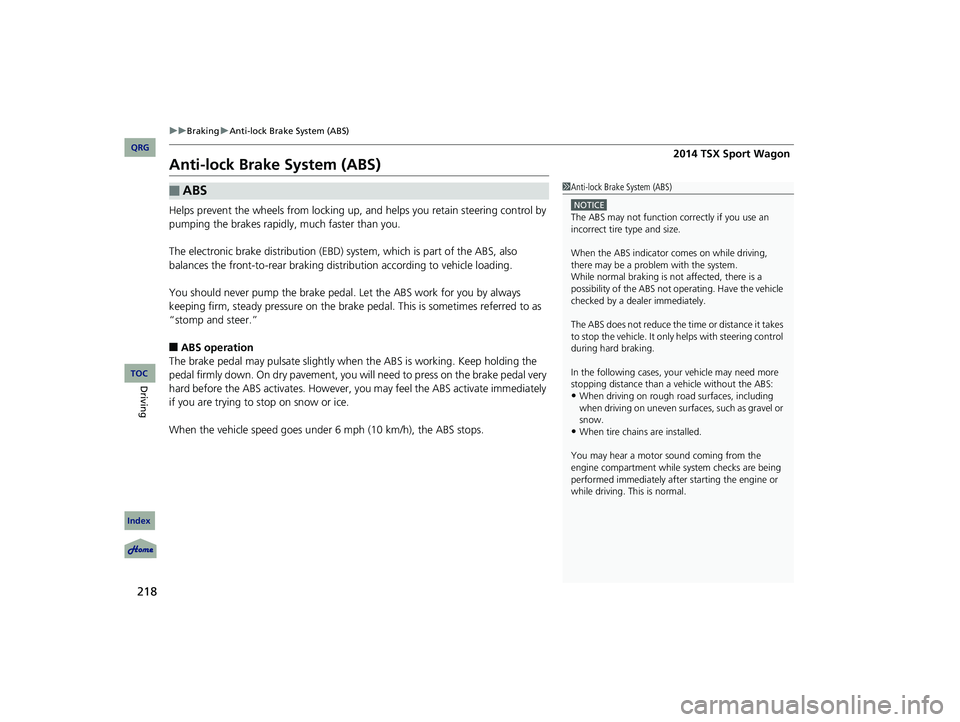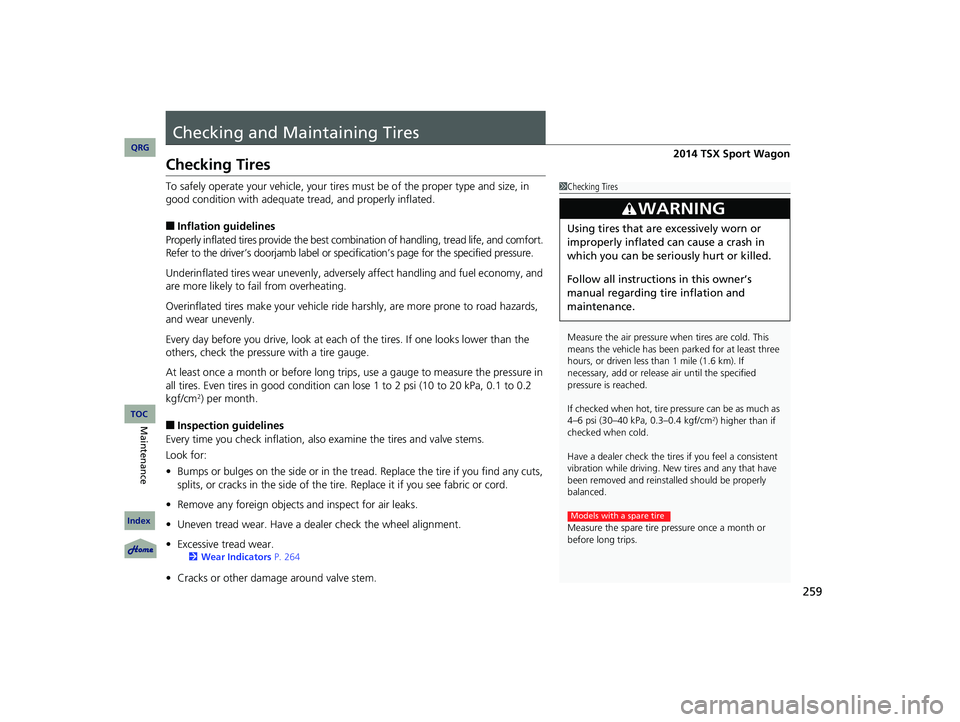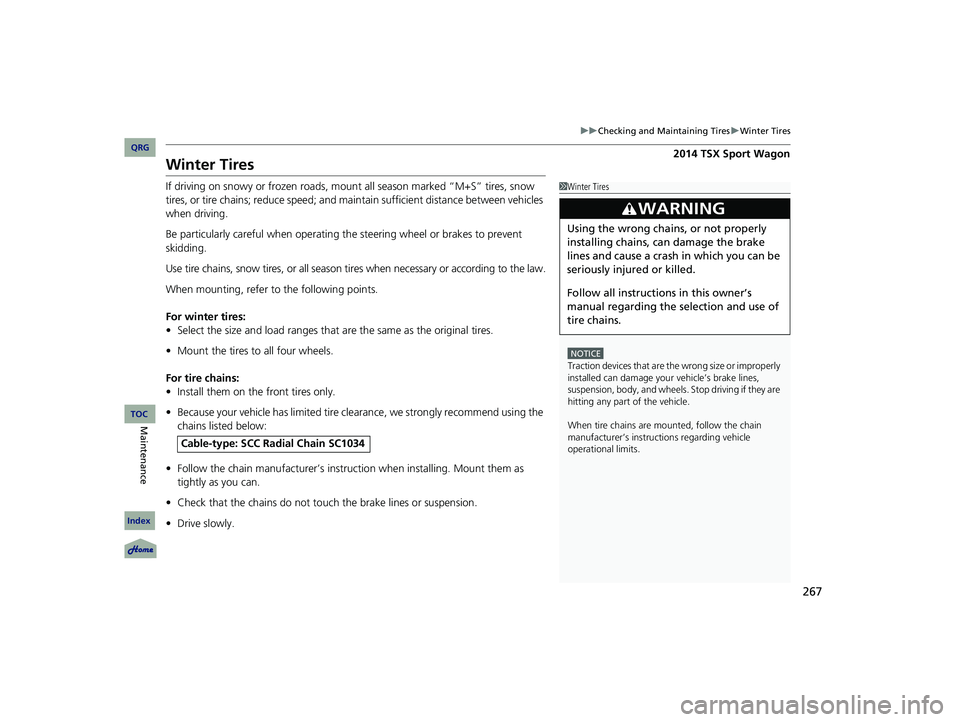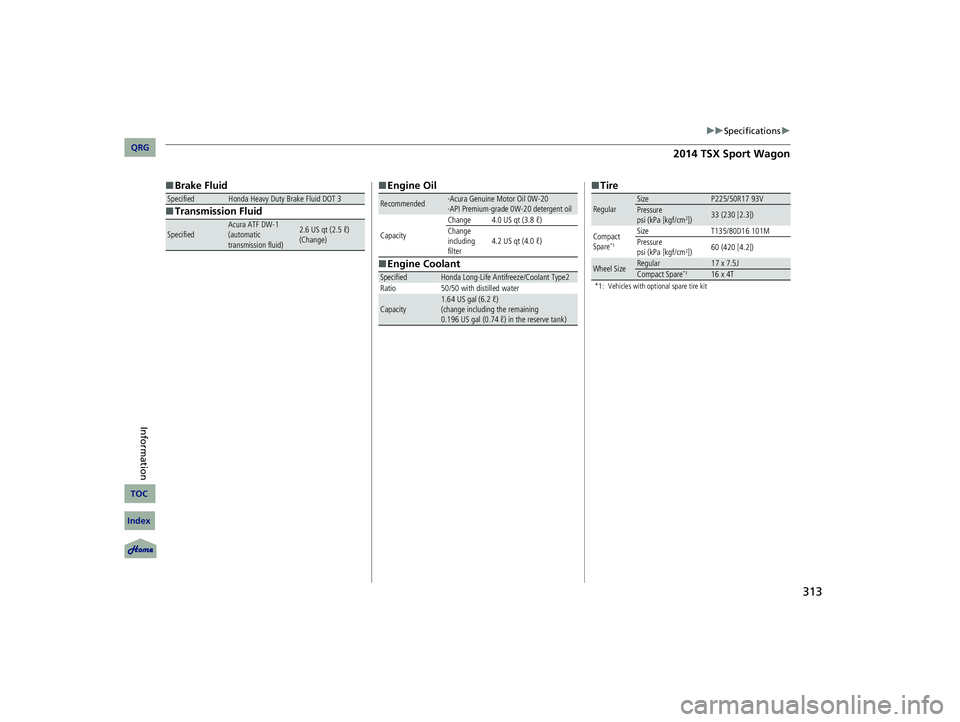wheel size Acura TSX 2014 Owner's Manual
[x] Cancel search | Manufacturer: ACURA, Model Year: 2014, Model line: TSX, Model: Acura TSX 2014Pages: 331, PDF Size: 16.94 MB
Page 219 of 331

218
uu Braking u Anti-lock Brake System (ABS)
Anti-lock Brake System (ABS)
Helps prevent the wheels from locking up, and helps you retain steering control by
pumping the brakes rapidly, much faster than you.
The electronic brake distribution (EBD) system, which is part of the ABS, also
balances the front-to-rear braking distri bution according to vehicle loading.
You should never pump the brake pedal. Let the ABS work for you by always
keeping firm, steady pressure on the brake peda l. This is sometimes referred to as
“stomp and steer.”
■ABS operation
The brake pedal may pulsate slightly when the ABS is working. Keep holding the
pedal firmly down. On dry pavement, you w ill need to press on the brake pedal very
hard before the ABS activates. However, you may feel the ABS activate immediately
if you are trying to stop on snow or ice.
When the vehicle speed goes under 6 mph (10 km/h), the ABS stops.
■ABS1Anti-lock Brake System (ABS)
NOTICEThe ABS may not function correctly if you use an
incorrect tire type and size.
When the ABS indicator comes on while driving,
there may be a problem with the system.
While normal braking is not affected, there is a
possibility of the ABS not operating. Have the vehicle
checked by a dealer immediately.
The ABS does not reduce the ti me or distance it takes
to stop the vehicle. It only helps with steering control
during hard braking.
In the following cases, your vehicle may need more
stopping distance than a vehicle without the ABS:
•When driving on rough road surfaces, including
when driving on uneven surfaces, such as gravel or
snow.
•When tire chains are installed.
You may hear a motor sound coming from the
engine compartment while system checks are being
performed immediately after starting the engine or
while driving. This is normal.
14 ACURA TSX 5D-31TL76300.book 218 ページ 2013年6月17日 月曜日 午後3時21分
QRG
Index
DrivingTOC
2014 TSX Sport Wagon
Page 260 of 331

259
Checking and Maintaining Tires
Checking Tires
To safely operate your vehicle, your tires must be of the proper type and size, in
good condition with adequate tread, and properly inflated.
■Inflation guidelines
Properly inflated tires provide the best combination of handli ng, tread life, and comfort.
Refer to the driver’s doorjamb label or specification’s page for the specified pressure.
Underinflated tires wear unevenly, adversel y affect handling and fuel economy, and
are more likely to fail from overheating.
Overinflated tires make your vehicle ride harshly, are more prone to road hazards,
and wear unevenly.
Every day before you drive, look at each of the tires. If one looks lower than the
others, check the pressure with a tire gauge.
At least once a month or before long trips , use a gauge to measure the pressure in
all tires. Even tires in good condition can lose 1 to 2 psi (10 to 20 kPa, 0.1 to 0.2
kgf/cm
2) per month.
■Inspection guidelines
Every time you check inflation, also examine the tires and valve stems.
Look for:
• Bumps or bulges on the side or in the tr ead. Replace the tire if you find any cuts,
splits, or cracks in the side of the tire. Replace it if you see fabric or cord.
• Remove any foreign objects and inspect for air leaks.
• Uneven tread wear. Have a deal er check the wheel alignment.
• Excessive tread wear.
2 Wear Indicators P. 264
• Cracks or other damage around valve stem.
1Checking Tires
Measure the air pressure when tires are cold. This
means the vehicle has been parked for at least three
hours, or driven less than 1 mile (1.6 km). If
necessary, add or releas e air until the specified
pressure is reached.
If checked when hot, tire pressure can be as much as
4–6 psi (30–40 kPa, 0.3–0.4 kgf/cm
2) higher than if
checked when cold.
Have a dealer check the tire s if you feel a consistent
vibration while driving. New tires and any that have
been removed and reinstalled should be properly
balanced.
Measure the spare tire pressure once a month or
before long trips.
3 WARNING
Using tires that are excessively worn or
improperly inflated can cause a crash in
which you can be seriously hurt or killed.
Follow all instructions in this owner’s
manual regarding tire inflation and
maintenance.
Models with a spare tire
14 ACURA TSX 5D-31TL76300.book 259 ページ 2013年6月17日 月曜日 午後3時21分
QRG
Index
MaintenanceTOC
2014 TSX Sport Wagon
Page 266 of 331

265
uu Checking and Maintaining Tires u Tire and Wheel Replacement
Tire and Wheel Replacement
Replace your tires with ra dials of the same size, load range, speed rating, and
maximum cold tire pressure rating (as shown on the tire’s sidewall). Using tires of a
different size or construction can cause the ABS and Vehicle Stability Assist (VSA ®)
system to work incorrectly.
It is best to replace all four tires at the same time. If that isn’t possible, replace the
front or rear tires in pairs.
Make sure that the wheel’s specifications match those of the original wheels.
If you replace a wheel, only use TPMS specified wheels approved for your vehicle.1 Tire and Wheel Replacement
3 WARNING
Installing improper tires on your vehicle can
affect handling and stability. This can cause
a crash in which you can be seriously hurt or
killed.
Always use the size and type of tires
recommended in this owner’s manual.
14 ACURA TSX 5D-31TL76300.book 265 ページ 2013年6月17日 月曜日 午後3時21分
QRG
Index
MaintenanceTOC
2014 TSX Sport Wagon
Page 268 of 331

267
uu Checking and Maintaining Tires u Winter Tires
Winter Tires
If driving on snowy or frozen roads, mount all season marked “M+S” tires, snow
tires, or tire chains; reduce speed; and maintain sufficient distan ce between vehicles
when driving.
Be particularly careful when operating the steering wheel or brakes to prevent
skidding.
Use tire chains, snow tires, or all season tires when necessary or according to the law.
When mounting, refer to the following points.
For winter tires:
• Select the size and load ranges that are the same as the original tires.
• Mount the tires to all four wheels.
For tire chains:
• Install them on the front tires only.
• Because your vehicle has limited tire clearance, we strongly recommend using the
chains listed below:
• Follow the chain manufacturer’s instru ction when installing. Mount them as
tightly as you can.
• Check that the chains do not touch the brake lines or suspension.
• Drive slowly.
Cable-type: SCC Radial Chain SC1034
1Winter Tires
NOTICETraction devices that are th e wrong size or improperly
installed can damage your vehicle’s brake lines,
suspension, body, and wheels. Stop driving if they are
hitting any part of the vehicle.
When tire chains are mounted, follow the chain
manufacturer’s instructions regarding vehicle
operational limits.
3 WARNING
Using the wrong chains, or not properly
installing chains, can damage the brake
lines and cause a crash in which you can be
seriously injured or killed.
Follow all instructions in this owner’s
manual regarding the selection and use of
tire chains.
14 ACURA TSX 5D-31TL76300.book 267 ページ 2013年6月17日 月曜日 午後3時21分
QRG
Index
MaintenanceTOC
2014 TSX Sport Wagon
Page 288 of 331

287Continued
If a Tire Goes Flat
Changing a Flat Tire
If a tire goes flat while driving, grasp the steering wheel firmly, and brake
gradually to reduce speed. Then, stop in a safe place. Replace the flat tire with
the compact spare tire. Go to a dealer as soon as possible to have the full-size tire
repaired or replaced.
1.Park the vehicle on firm, level, and non-slippery surface and apply the
parking brake.
2. Move the shift lever in
(P
.
3. Set the parking brake.
4. Turn on the hazard warn ing lights and turn the ignition switch to LOCK
(0
.
Vehicles with optional spare tire kit
1Changing a Flat Tire
Periodically check the tire pressure of the compact
spare. It should be set to the specified pressure.
Specified Pressure: 60 psi (420 kPa, 4.2 kgf/cm
2)
When driving with the co mpact spare tire, keep the
vehicle speed under 50 mph (80 km/h). Replace with
a full-size tire as soon as possible.
The compact spare tire and wheel in your vehicle are
specifically for this model.
Do not use them with another vehicle.
Do not use another type of compact spare tire or
wheel with your vehicle.
Do not mount tire chains on a compact spare tire.
If a chain-mounted front tire goes flat, remove one of
the full-size rear tires and replace it with the compact
spare tire. Remove the flat front tire and replace it will
the full-size tire that was removed from the rear.
Mount the tire chains on the front tire.
14 ACURA TSX 5D-31TL76300.book 287 ページ 2013年6月17日 月曜日 午後3時21分
QRG
Index
Handling the Unexpected
TOC
2014 TSX Sport Wagon
Page 293 of 331

uu If a Tire Goes Flat u Changing a Flat Tire
292
1. Remove the center cap and place the flat
tire face down in the spare tire well.
2. Remove the spacer cone from the wing
bolt, flip it over, and insert it back on the
bolt. Secure the flat tire with the wing bolt.
3. Securely put the jack and wheel nut wrench
back in the tool case. Store the case in the
cargo area.
If you replace a flat tire with the spare tire, the low tire pressure/TPMS indicator
comes on while you are driving. After dr iving for a few miles (kilometers), the
indicator will start blinking for a short time and then stay on. CHECK TPMS
SYSTEM appears on the multi-information display, but this is normal.
If you replace the tire with a specified regular tire, the warning message on
the multi-information display and the TPMS indicator will go off after a few
miles (kilometers).
■Storing the Flat Tire1Storing the Flat Tire
3 WARNING
Loose items can fly around the interior
in a crash and can seriously injure the
occupants.
Store the wheel, jack, and tools securely
before driving.
Spacer
Cone Wing
Bolt
For
compact
spare tire For
full-size
tire
■TPMS and the Spare Tire1 TPMS and the Spare Tire
The system cannot monitor the pressure of the spare
tire. Manually check the spare tire pressure to be sure
that it is correct.
Use TPMS specific wheels. Each is equipped with a
tire pressure sensor mount ed inside the tire behind
the valve stem.
14 ACURA TSX 5D-31TL76300.book 292 ページ 2013年6月17日 月曜日 午後3時21分
QRG
Index
Handling the Unexpected
TOC
2014 TSX Sport Wagon
Page 314 of 331

313
uu Specifications u
■Brake Fluid
■ Transmission FluidSpecifiedHonda Heavy Duty Brake Fluid DOT 3
SpecifiedAcura ATF DW-1
(automatic
transmission fluid)2.6 US qt (2.5 ℓ)
(Change)
■Engine Oil
■ Engine Coolant
Recommended·Acura Genuine Motor Oil 0W-20
·API Premium-grade 0W-20 detergent oil
Capacity Change
4.0 US qt (3.8 ℓ)
Change
including
filter 4.2 US qt (4.0 ℓ)
SpecifiedHonda Long-Life Antifreeze/Coolant Type2
Ratio 50/50 with distilled water
Capacity1.64 US gal (6.2 ℓ)
(change including the remaining
0.196 US gal (0.74 ℓ) in the reserve tank)
■ Tire
*1: Vehicles with optional spare tire kit
RegularSizeP225/50R17 93VPressure
psi (kPa [kgf/cm2])33 (230 [2.3])
Compact
Spare
*1Size T135/80D16 101M
Pressure
psi (kPa [kgf/cm
2]) 60 (420 [4.2])
Wheel SizeRegular17 x 7.5JCompact Spare*116 x 4T
14 ACURA TSX 5D-31TL76300.book 313 ページ 2013年6月17日 月曜日 午後3時21分
QRG
Index
Information
TOC
2014 TSX Sport Wagon